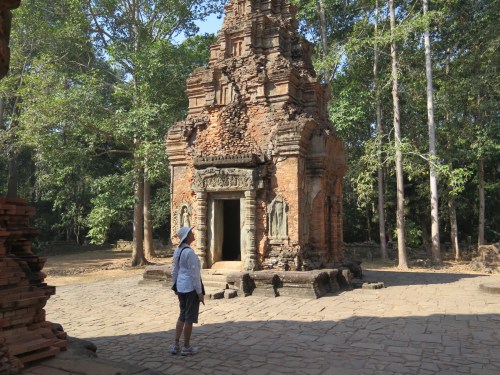When we first started to explore the idea of traveling to Cambodia we were focused on a river journey on the Mekong River from Siem Reap to Ho Chi Min City in Vietnam. We had so enjoyed our river trip in Borneo to see the orangutans and we wanted to experience the Mekong in the same way. Turns out that cruise wasn’t even close to fitting our travel budget and besides, the river runs out of water in the dry season and some years you have to be transported by bus to a port closer to the delta until the river is navigable. No thanks, even if we could afford it.
Alternatively we learned of a half day river excursion to the Silk Island that held some appeal, but there’s that aversion to being herded we spoke of before so joining a tour, even to traverse a little of the Mekong, put us right off.
Our driver Sambo solved our dilemma when he suggested he take us across the river to the Silk Island himself and we could have a private tour of the silk production. It was our last day, our last opportunity to get on the river, even if it was only a ferry. We gave Sambo the go-ahead and climbed aboard his now familiar tuktuk.


We enjoyed the long ride that led us out through the streets of Phnom Penh toward the river and a local ferry.

Jack and I walked aboard and climbed to the upper deck, but as the ferry prepared to pull away it looked like there wouldn’t be room for our tuktuk. At the last minute, Sambo drove onto the ramp and that’s how we traversed the river, with Sambo’s tuktuk barely hanging on at the edge of the ramp.

The river crossing was brief but satisfying and transported us back into our familiar water world.




On the other side we found lush fields and a glimpse of rural life. Sambo found it amusing that we asked him to stop so we could photograph the crops, but it’s been a long time since we were in an agricultural area.


The silk operation is a small enterprise I suspect was just created for the tourist trade, but our young volunteer guide enthusiastically practiced her English describing the process from the eggs to the moths to pupae to cocoons. Jack and I had a theoretical knowledge from school days but it was great to learn it all again first hand and to be able to see and touch each step of the process.


I love process, and following the steps from raw material to final product was what much of my work life in industrial video involved. I always thought of silk as a delicate frou-frou material but our guide emphasized how very strong it is, and we remembered that parachutes used to be made of silk.


The fabric woven at this site is sold only here and they weave beautiful complex patterns. It takes weeks to set up the loom and weeks to weave the length of fabric. The colors are mostly chemical dyes now.


After my experience attempting weaving in Buton, I was in awe of the concentration required for these complicated patterns. Most of the weavers learned their craft at the feet of their mothers and grandmothers, just like the weavers we met in Indonesia.
Our “tour” ended, as they always do, at the gift shop where I spent a long time deciding on what to buy. Everything was beautiful but we live on a boat and have limited space or use for fancy silk things. That doesn’t mean I didn’t want to admire and touch everything in the shop while Jack and our guide chatted in the shade outside.
The island is beautiful and quiet and our guide told us it’s a weekend destination for city dwellers needing a break from the urban dust and noise.


We woke Sambo from his nap and began the long trek back across the river to Phnom Penh. This quiet trip was one of our favorite excursions in Cambodia, and in the end satisfied our desire to experience something of the Mekong River.





















































































 A few interesting conversations: A guide overheard us talking and asked where we’re from. He told us few Americans visit Angkor, and that the greatest number of tourists come from China and France. I heard quite a few Australians, some Russians and the occasional German group, too. Our driver told us later the German-speaking guides cost extra.
A few interesting conversations: A guide overheard us talking and asked where we’re from. He told us few Americans visit Angkor, and that the greatest number of tourists come from China and France. I heard quite a few Australians, some Russians and the occasional German group, too. Our driver told us later the German-speaking guides cost extra.